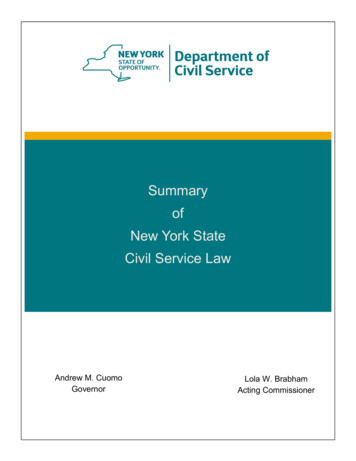
Transcription
SummaryofNew York StateCivil Service LawAndrew M. CuomoGovernorLola W. BrabhamActing Commissioner
A Message from the President.Appointments and promotions in New York State civil service are made according tomerit and fitness as mandated by the New York State Constitution. There are many laws thatcontain provisions dealing with civil service matters, with the majority of them provided in theCivil Service Law, Rules and Regulations.This newly-revised guide summarizes important aspects of the statutory basis for ourState's merit system of public employment. It is a valuable reference tool that provides increasedaccess to information about the laws, rules and regulations that affect the civil service system.I hope that you find the Summary of New York State Civil Service Law useful.i
A Note About Municipal GovernmentThis Summary includes provisions of Civil Service Law that only apply to employmentin State government. Information regarding employment in municipal government (includingcounties, cities, towns, villages, school districts and special districts) or the application of aparticular provision of Civil Service Law to municipal employment can be obtained from theappropriate municipal civil service agency.Each of the 101 municipal civil service agencies has adopted rules to carry into effect theprovisions of Civil Service Law. The municipal rules have the force and effect of law, andgovern many aspects of merit system administration in the municipalities. These rules should bereferred to for the specific provisions that apply to particular municipalities.ii
Abbreviation KeyThis Summary includes abbreviations of citations of laws, rules and regulations. Below is a keyto those abbreviations.CSLCivil Service LawCSRClassified Service RulesCFRCode of Federal RegulationsMLMilitary LawNYCRRNew York Codes, Rules and RegulationsPOLPublic Officers LawPRRegulations of the Department of Civil Service(President's Regulations)RSSLRetirement and Social Security LawUSCUnited States Codeiii
Summary of New York StateCivil Service LawTable of ContentsPageSources of the Law Governing Civil Service . 1Civil Service Law, Rules and Regulations . 1Civil Service Administration . 2The Department and the Commission . 2Department and Commission Jurisdiction . 3Jurisdictional Classification . 3Unclassified and Classified Service . 3Exempt Class . 3Non-Competitive Class . 4Labor Class . 4Competitive Class . 5Reclassification . 5Continuation of Employment in Takeovers by the State . 5Classification and Compensation . 5Reclassification . 6Bargaining Units . 6Hiring to Job Rate . 7Geographic/Pay Differentials . 7Examinations . 7Applications/Requirements . 7Promotion . 8Open-Competitive . 8Non-competitive Class Eligibility for Promotion . 8Eligible Lists . 9Duration . 9Ranking . 9“Continuing” Eligible Lists . 9Certification Order. 9Filling Vacancies . 10Combining Lists . 10Certification by Locality . 10iv
Permanent Appointment . 11Canvass and Offer of Appointment . 11Failure to Respond to Canvass, Declining Appointment . 11Permanent Appointment to Competitive Position on Non-competitive Basis . 12Trainee Appointments . 12Seasonal Appointments . 12Contingent Permanent Status . 13Probationary Term . 13Requirements . 13Duration . 14Absence . 14Probationary Reports . 15Termination/Resignation . 15Non-Permanent Appointments . 16Temporary . 16Provisional . 16Tenure Rights . 17Reassignment . 17Transfers . 18Conditions and Limitations . 18Transfer to Avert Layoffs . 18Geographical Areas . 18Agency Functions . 19Administrative Positions . 19Resignation and Reinstatement . 19Effective Date . 19Incompetency or Misconduct Charges . 20Redeployments . 20Layoffs and Preferred Lists . 21Criteria for Having Rights . 21Seniority . 21Layoff Units . 22“Bumping” and “Retreating” . 22Placement Rosters . 22Preferred Lists . 22Preferred List Reinstatements . 23Term of Eligibility . 23Reemployment Rosters . 23v
Disciplinary Proceedings . 24Those Subject to Provisions . 24Investigations . 25Charges . 25Hearings . 25Suspension/Dismissal . 26Appeals . 26Leave for Disability . 27Length of Leave . 27Medical Examinations . 27Termination/Reinstatement . 28Veterans’ Rights . 28Additional Credits for Examinations . 28Eligibility . 28Time of War . 29Use of Credits . 29Preference in Retention . 30War Veterans and Exempt Volunteer Firefighters . 30Military Service and Leave of Absence . 30Entitlement to Examinations . 31Appointment While on Military Duty . 32Credit Toward Probationary Requirements . 33Age Requirements . 33Leave for Education . 33Political Activity . 33Rules of Conduct . 33Federally Funded State Agencies . 33Strikes . 34The Ethics Law and Outside Activities . 34Dual Employment . 34Financial Disclosure . 34Additional Agency Restrictions . 34Certification . 35vi
Sources of the Law Governing Civil ServiceCivil Service Law, Rules and RegulationsThe Civil Service Law and the Rules and Regulations promulgated there under, implementthe mandate of the State Constitution, Article V, section 6, which provides that:"Appointments and promotions in the civil service of the State and all of the civil divisionsthereof, including cities and villages, shall be made according to merit and fitness to be ascertained,as far as practicable, by examination which, as far as practicable, shall be competitive, ."Article V, section 6 also provides for additional credits in competitive examinations forcertain disabled and non-disabled veterans. Since this preference for veterans is inconsistent with theconstitutional requirement of competition, it was necessary that provision for such credits beincluded in the Constitution itself.The majority of the provisions pertaining to civil service procedures and requirements in theState service are contained in the Civil Service Law, the Rules for the Classified Service, theRegulations of the State Civil Service Commission (Commission's Regulations) and the Regulationsof the Department of Civil Service (President's Regulations). The Rules and Regulations implementthe Law and provide procedures for carrying out the principles expressed in the Constitution andLaw. The Rules and Regulations, of course, must be consistent with the Law.The principal rules governing the recruitment of personnel and personnel changes, includingexaminations, appointments, promotions, transfers and reinstatements, are contained in the Rules forthe Classified Service. The Rules for the Classified Service are subject to the approval of theGovernor and take effect when filed with the Department of State. These Rules apply to allemployment under the jurisdiction of the State Department of Civil Service.The Attendance Rules for Employees in New York State Departments and Institutions,commonly referred to simply as the Attendance Rules, govern such matters as vacation, sick leave,holidays and other time allowances. They apply to officers and employees in the classified service inthe Executive Branch of the State government.In addition to the Civil Service Law, Rules and Regulations, there are many other lawscontaining provisions dealing with civil service matters. For example, there are